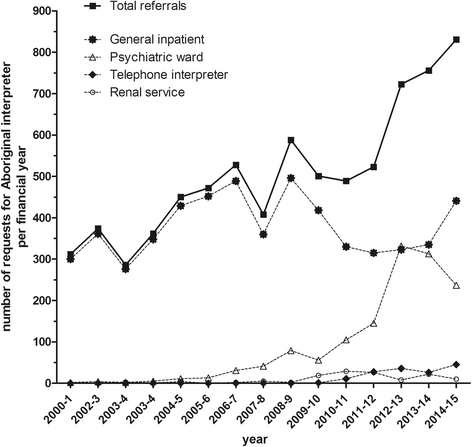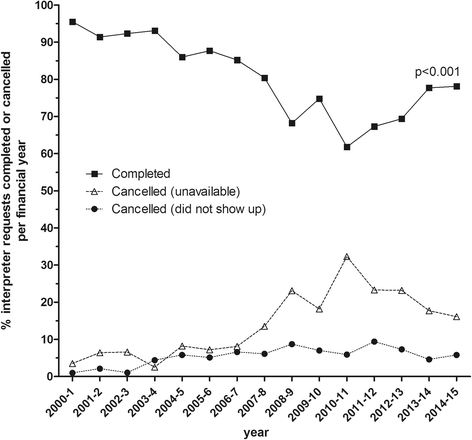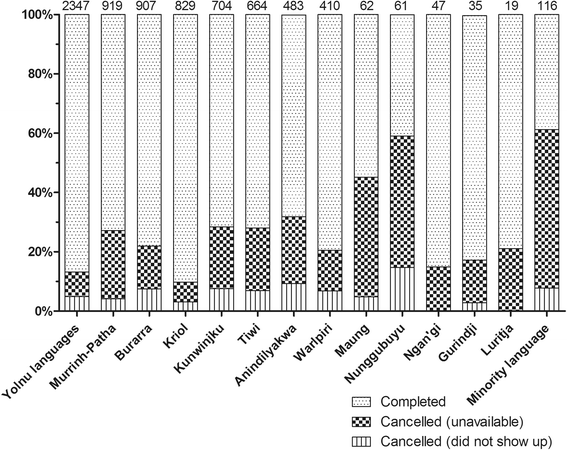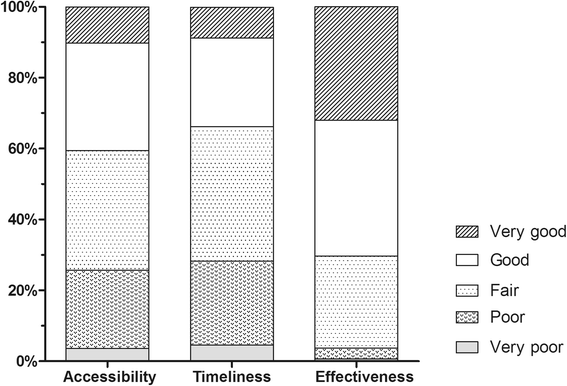Low uptake of Aboriginal interpreters in healthcare: exploration of current use in Australia's Northern Territory
- PMID: 29141623
- PMCID: PMC5688693
- DOI: 10.1186/s12913-017-2689-y
Low uptake of Aboriginal interpreters in healthcare: exploration of current use in Australia's Northern Territory
Abstract
Background: In Australia's Northern Territory, most Aboriginal people primarily speak an Aboriginal language. Poor communication between healthcare providers and Aboriginal people results in adverse outcomes including death. This study aimed to identify remediable barriers to utilisation of Aboriginal Interpreter services at the Northern Territory's tertiary hospital, which currently manages over 25,000 Aboriginal inpatients annually.
Methods: This is a multi-method study using key stakeholder discussions, medical file audit, bookings data from the Aboriginal Interpreter Service 2000-2015 and an online cross-sectional staff survey. The Donabedian framework was used to categorise findings into structure, process and outcome.
Results: Six key stakeholder meetings each with approximately 15 participants were conducted. A key structural barrier identified was lack of onsite interpreters. Interpreter bookings data revealed that only 7603 requests were made during the 15-year period, with completion of requests decreasing from 337/362 (93.1%) in 2003-4 to 649/831 (78.1%) in 2014-15 (p < 0.001). Non-completion was more common for minority languages (p < 0.001). Medical files of 103 Aboriginal inpatients were audited. Language was documented for 13/103 (12.6%). Up to 60/103 (58.3%) spoke an Aboriginal language primarily. Of 422 staff who participated in the survey, 18.0% had not received 'cultural competency' training; of those who did, 58/222 (26.2%) indicated it was insufficient. The Aboriginal Interpreter Service effectiveness was reported to be good by 209/368 (56.8%), but only 101/367 (27.5%) found it timely. Key process barriers identified by staff included booking complexities, time constraints, inadequate delivery of tools and training, and greater convenience of unofficial interpreters.
Conclusion: We identified multiple structural and process barriers resulting in the outcomes of poor language documentation and low rates of interpreter bookings. Findings are now informing interventions to improve communication.
Conflict of interest statement
Ethics approval and consent to participate
This study was approved by the Human Research Ethics Committee (HREC), Northern Territory Department of Health and Menzies School of Health Research (HREC-2015-2465). Patient consent was not required since no patients were directly approached by study investigators and the data used comprised only retrospective de-identified data from the Aboriginal Interpreter Service database, and medical file audit conducted by a clinical nurse practitioner then de-identified. Waiver of consent was approved by the approving HREC.
Consent for publication
Not applicable.
Competing interests
All authors have no competing interests to declare.
Publisher’s Note
Springer Nature remains neutral with regard to jurisdictional claims in published maps and institutional affiliations.
Figures




References
-
- Coroners Court Alice Springs. Inquest into the death of Kristelle Ruby Mulladad aka Oliver. FIndings of Mr Greg Cavanagh SM. https://www.nt.gov.au/__data/assets/pdf_file/0008/208781/a00572008-krist... 29 October 2010.
-
- Napier AD, Ancarno C, Butler B, Calabrese J, Chater A, Chatterjee H, Guesnet F, Horne R, Jacyna S, Jadhav S, Macdonald A, Neuendorf U, Parkhurst A, Reynolds R, Scambler G, Shamdasani S, Smith SZ, Stougaard-Nielsen J, Thomson L, Tyler N, Volkmann AM, Walker T, Watson J, Williams AC, Willott C, Wilson J, Woolf K. Culture and health. Lancet. 2014;384(9954):1607–1639. doi: 10.1016/S0140-6736(14)61603-2. - DOI - PubMed
MeSH terms
LinkOut - more resources
Full Text Sources
Other Literature Sources
Medical

